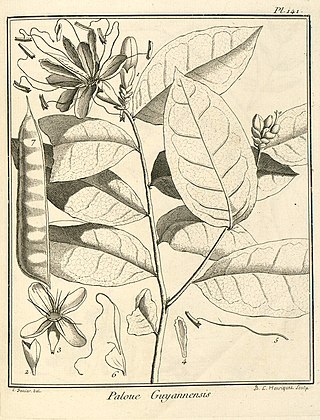
Aparisthmium is a plant genus of the family Euphorbiaceae first described as a genus in 1840. It contains only one known species, Aparisthmium cordatum, native to South America and Costa Rica.

Goupia is a neotropical genus of flowering plants and the sole genus included in the family Goupiaceae. There are three species, all found in tropical northern South America.

Tachigali is a flowering plant genus in the legume family (Fabaceae). It includes 74 species of trees native to the tropical Americas, ranging from Nicaragua to Bolivia, Paraguay, and southern Brazil. Typical habitats include tropical rain forest, lower montane forest, seasonally-flooded and non-flooded evergreen lowland forest and woodland, gallery and riparian forest, sometimes on white sands, cerrado and other dry woodland, and rocky grassland.

Nephrosperma vanhoutteanum is a species of palm tree, and the only species in the genus Nephrosperma. It is found only in Seychelles, where it is threatened by habitat loss.

Roscheria is an endangered, monotypic genus of flowering plant in the palm family. The genus is named for Albrecht Roscher, a 19th-century German explorer, and the epithet for its single species R. melanochaetes derives from Latin and Greek meaning 'black' and 'bristle', alluding to the spines covering the trunks. They naturally occur on the Mahé and Silhouette Islands of Seychelles where they grow in mountainous rainforest and are threatened by habitat loss.

Satranala decussilvae is a species of flowering plant in the Arecaceae family. It is a palm endemic to Madagascar. It is the only species in the genus Satranala, and is threatened by habitat loss. There are perhaps 200 mature individuals remaining.

The rose-breasted chat is a species of bird in the family Cardinalidae, the cardinals or cardinal grosbeaks. It is found in Bolivia, Brazil, Colombia French Guiana, Guyana, Suriname and Venezuela.
Glionnetia is a monotypic genus of flowering plants in the family Rubiaceae. The genus contains only one species, viz. Glionnetia sericea, which is endemic to Mahé and Silhouette Island in the Seychelles. The species thrives mainly on high ridges in the mountains and it does not seem to grow well at lower altitudes. Glionnetia sericea is a small flower with paniculate terminal inflorescences and it has capsules that are dispersed by wind.
Iryanthera is a flowering plant genus in the family Myristicaceae.
Manilkara paraensis is a species of plant in the family Sapotaceae. It is endemic to Brazil, where it is threatened by habitat loss.

Parkia is a genus of flowering plants in the family Fabaceae. It belongs to the mimosoid clade of the subfamily Caesalpinioideae. Several species are known as African locust bean.

Paloue is a genus of flowering plants in the family Fabaceae. It belongs to the subfamily Detarioideae. The genera was first created with the description of Paloue guianensis by Aublet in 1775.

Griffinia is a genus of Brazilian plants in the Amaryllis family, subfamily Amaryllidoideae. It includes 23 known species which are endemic to Brazil. The most closely related genus to it is the monotypic Worsleya.
Amphiodon effusus is a species of flowering plant in the family Fabaceae. It is a tree found in non-flooded areas of the Amazon rainforest. It is the only member of the genus Amphiodon.

Hypericum minutum is a species of flowering plant in the St John's wort family Hypericaceae. It is a small perennial herb that grows in tufts. It has slender and brittle stems, flowers in clusters of one to three, yellow petals with black and amber glands, few stamens, and a seed capsule with narrow grooves. H. minutum is closely related to H. huber-morathii and H. sechmenii and resembles a smaller form of the latter plant. The plant is endemic to Turkey, and is found among limestone rocks in a limited region of southwestern Anatolia. Originally excluded from a comprehensive monograph of Hypericum, the species' placement within the genus is unclear. It has been placed in both section Adenosepalum and section Origanifolium.

Brosimum guianense, called snakewood, letterwood, leopardwood, and amourette, is a species of flowering plant in the genus Brosimum, native to southern Mexico, Central America, Trinidad, and tropical South America. A tree reaching 40 m (130 ft), its heartwood can command a price of $30 per kg.
Cyrillopsis is a genus of flowering plants belonging to the family Ixonanthaceae.
Endopleura is a genus of flowering plants belonging to the family Humiriaceae. It is a monotypic genus consisting of the species Endopleura uchi(Huber) Cuatrec.. Its native range is Northern Brazil.
Parinariopsis is a monotypic genus of flowering plants belonging to the family Chrysobalanaceae. The only species is Parinariopsis licaniiflora.












